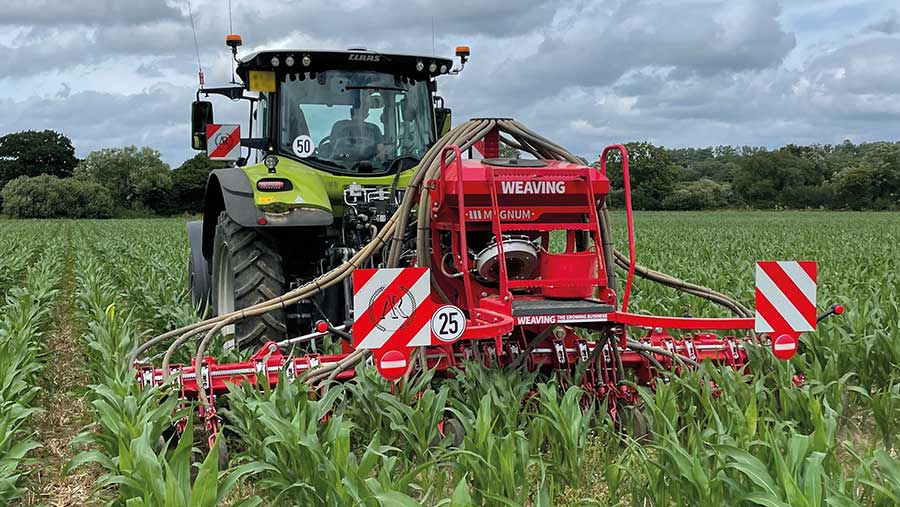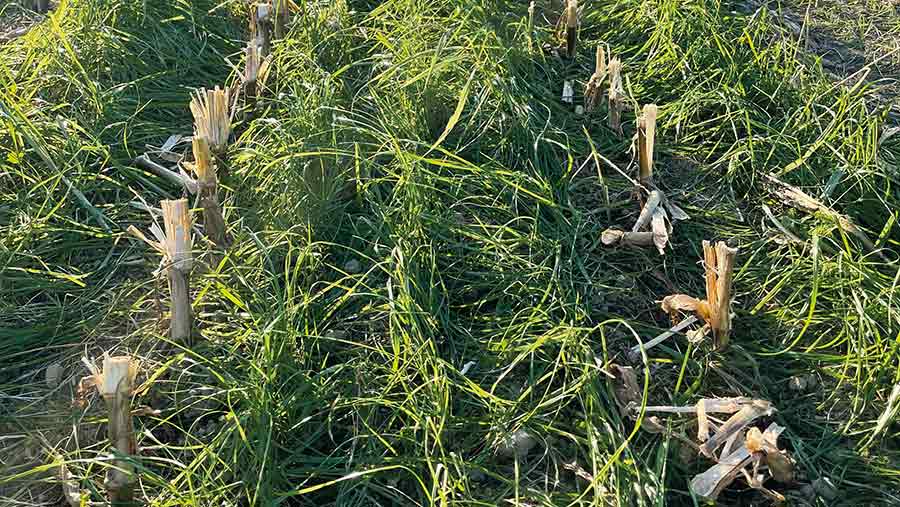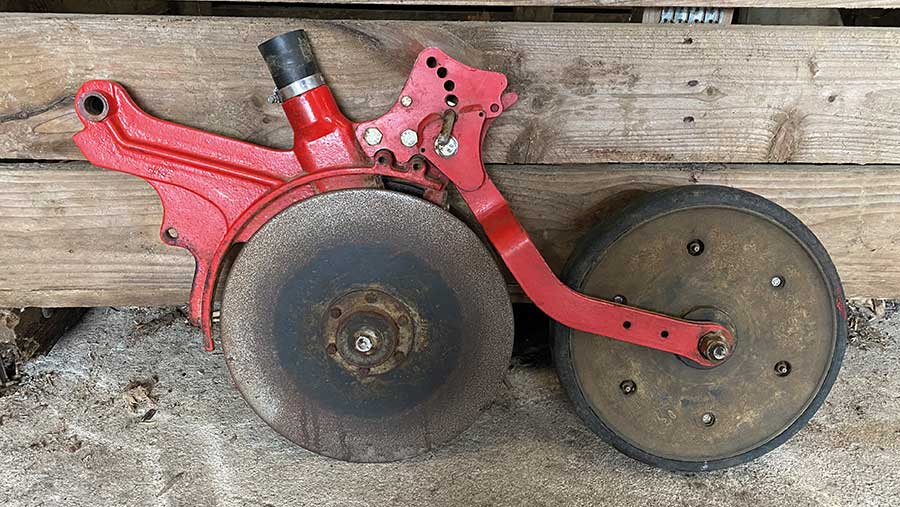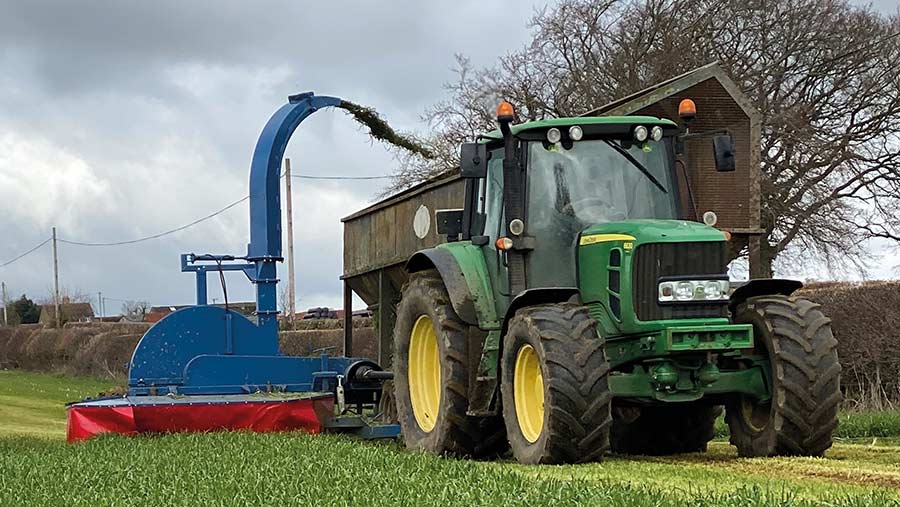Benefits of undersowing maize for soil, water and grazing
 Contractor George Fraser's Weaving IR drill undersowing the maize © AR Fraser Contracting
Contractor George Fraser's Weaving IR drill undersowing the maize © AR Fraser Contracting Tom Kimber has been growing maize at Higher Stavordale Farm near Wincanton in Somerset for at least 10 years, but it is only recently that he has turned his focus to improving the crop’s environmental credentials.
Undersowing is becoming a key part of this strategy, allowing the farm – operated in partnership with his parents, Paul and Ruth – to produce maize for its 220 dairy cows and 250 head of beef in a more sustainable way.
See also: How forage maize no-till system cuts costs and improves soil
Since its introduction, maize has been grown exclusively on the farm’s best soils.
However, leaving maize stubble on bare land over the winter is increasingly regarded as unacceptable, and since the maize fields slope down towards the main road, surface run-off can be both forcible and visible.
Loss of water and nutrients, and the potential pollution of watercourses, particularly with phosphorus (P) and nitrogen (N), are not the only risks.
As Mr Kimber observes: “If the run-off is brown, you know that’s your topsoil disappearing down the road.”
So the family looked for a workable solution that would give the crop a sustainable future on their land and could also help them qualify for Countryside Stewardship.
They did this off their own bats in 2021, and continued with the same approach in 2022, but with the benefit of about £100/ha funding from Wessex Water’s River Stour Phosphorus Reduction Scheme.
The first step was to undersow the maize with Italian ryegrass using a Weaving IR specialist inter-row drill.
This allowed three rows of grass to be drilled between each row of maize in early June, when the crop was at the 6-8 leaf stage and had not quite covered the rows.
The drill has a double disc opener and a rubber press wheel, which is essential for giving good seed-to-soil contact, says George Fraser of A&R Fraser Contracting, which undertook the drilling.

Italian ryegrass after the maize harvest © A&R Fraser
Why Italian ryegrass?
Italian ryegrass was chosen as a “cheap and cheerful option” and was sown at a rate of about 20kg/ha between the maize rows, according to the farm’s agronomist, Giles Simpson of Pearce Seeds.
“It was quick growing, as it’s important to get the roots down as you need a root system to keep the soil in the field,” he says.
It is also said to be hard to beat as a nutrient scavenger and able to survive in the shade of the maize.
Farm facts: Higher Stavordale Farm, Wincanton
- 182ha (450 acres), including 29ha (71 acres) maize
- Grassland on heavy clay soils; maize on free-draining, stone brash soils
- 220 dairy cows producing 7,964 litres at 4.4% butterfat and 3.5% protein
- 250 head of Angus crosses from the dairy herd
- Farm shop selling the farm’s own beef, turkeys and Gloucester Old Spot pork
Weed control in maize must not be compromised by the undersown crop, says Mr Simpson.
At Higher Stavordale Farm, a pre-emergence herbicide was used straight after drilling maize and a further spray applied for broadleaf weed control at the 3-4 leaf stage.
The grass was undersown three to four weeks later when the maize was 20-25cm tall.
When the maize was harvested on 17 September, Mr Fraser says the grass kept the machinery off the soil, there were fewer wheelings and there was less mud on the road.
And the forage maize yield and composition were no lower than the farm’s previous single stands of the crop – yield in 2021 averaged just over 45t/ha.
However, yield was seriously affected by drought in 2022, when the average was about 23.4t/ha.
Grazing bonus
After harvest, the undersown ryegrass, which was well established, was given two more months to grow without further fertiliser, before 35 Angus-cross cattle were put on to the field.
“The grass grew a lot in those two months and the cattle grazed it without supplementation for two weeks in November,” says Mr Kimber.
“They then remained on the field until 8 February, during which time they were fed silage in trailers.”
By early March, the winter-grazed sward was sparse, but Mr Kimber was certain it had held the soil in place on a very sloping field, even during deluges of winter rain.
He said this could be further improved if crops could be drilled across the slope.
The field will be returned to maize this spring after fertilising, muckspreading and ploughing.
Targeted funding
Tim Stephens, Wessex Water’s catchment adviser, says the aim in the area around Higher Stavordale Farm is to prevent the run-off of phosphates in the catchment of the River Stour and the Somerset Levels.
In other areas, most notably on chalk, nitrates would be the driver, but an excess of either nutrient could fuel algal growth in watercourses, starving them of oxygen and life.
He recommends farmers contact their regional water company for information on similar schemes, or consider Mid Tier options under Countryside Stewardship for undersowing, buffer strips and in-field grass strips.

One of the Weaving drill’s disc and press wheel units © Ann Hardy
Whether the target is P or nitrates, undersowing has been found to reduce leaching by about 50% compared with bare stubble, he says.
“The earlier established the cover crop, the more effective it is at controlling leaching, which means undersowing often has an advantage over post-harvest sowing,” he says (see “Post-harvest cropping as an alternative to undersowing”).
He stresses that undersowing should be part of a package of measures, including grass buffer strips on targeted areas such as adjoining roads and watercourses or in corners of fields.
These too could be eligible for either Wessex Water or government funding.
Long-term environmental benefits
On Higher Stavordale Farm, the Wessex Water grant more than covered the cost of undersowing, according to the farm’s adviser, Richard Lane from The Dairy Group.
He says the practice can add “unquantifiable, long-term value”, in the form of improvements in soil structure, water holding capacity, organic matter and N and P indexes.
An undersown crop also has the potential to increase forage production, reduce costs of production and build soil carbon, he adds.
Post-harvest cropping as an alternative to undersowing

© Ann Hardy
A further 12ha (30-acre) maize field at Higher Stavordale Farm was sown with Italian ryegrass immediately following harvest in mid-September, after flail topping the maize stubble.
It was ready to harvest with a zero grazer from 1 March at a rate of 0.4ha/day. It will then be fertilised and cut once for silage.
After fertilising and muckspreading it will be ploughed and put back into maize this spring.
Also potentially grant-eligible, this winter cover crop is expected to have cut nutrient losses compared with bare stubble, but not by quite as much as a well-established undersown crop.
Mr Kimber says it also provided valuable extra forage at a time of scarcity and had been calculated to give a net saving in the dairy herd of 38p a head a day after collection costs.
Tom Kimber, George Fraser, Giles Simpson, Tim Stephens and Richard Lane were all speaking at a recent AHDB workshop on undersowing maize held at Higher Stavordale Farm
